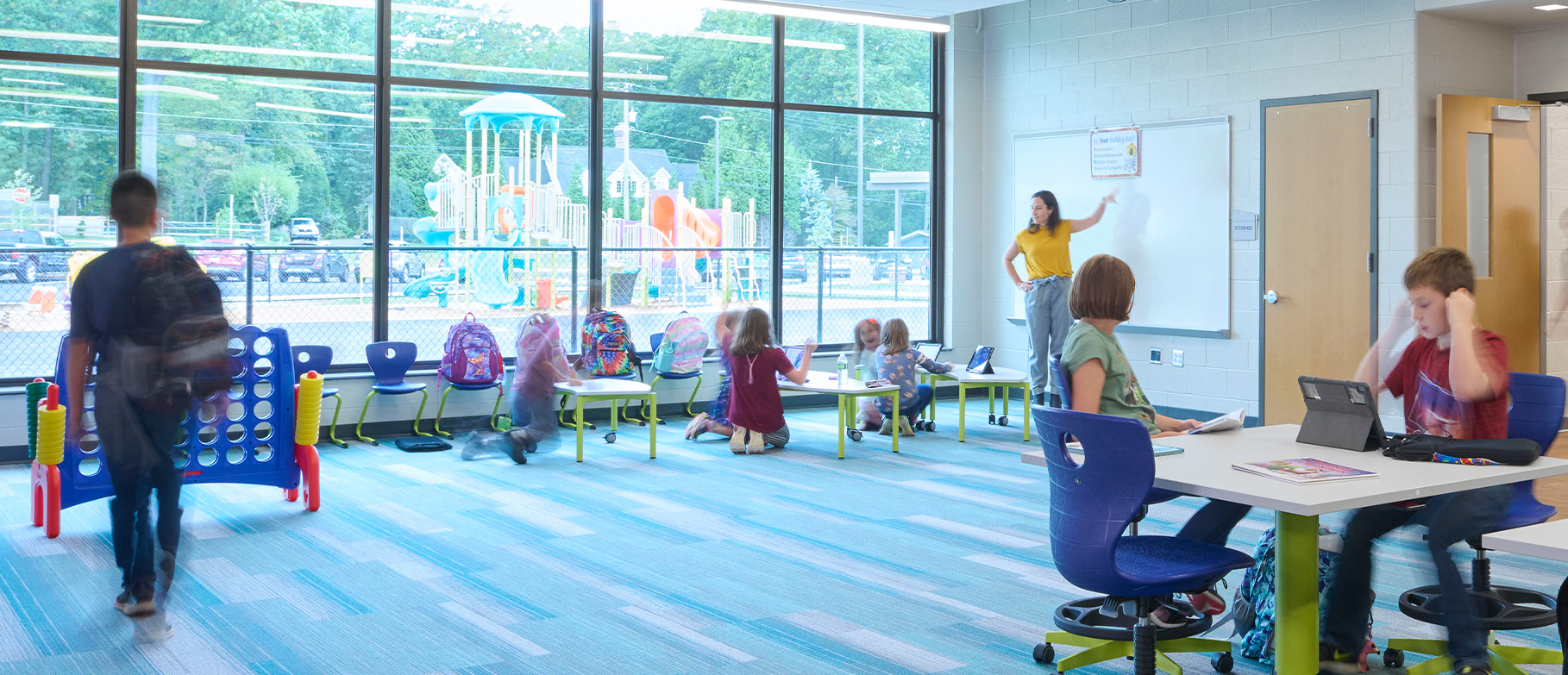Posts
Low-Floor Learning
May 16, 2023
Students need to have flexible seating options.
For anyone who has completed a K-12 education, it’s highly likely that his/her least favorite part of the school day was sitting in a desk. And just sitting there. All day. Yet, when we consider the history of formal education, not much has changed when it comes to sitting at a desk. Over 150 years ago students were sitting at desks in one room schoolhouses. If you walk into a K-12 building today, you’ll likely still see students sitting in desks; however, research shows that children don’t perform their best when they’re sitting all day. So how do we address this issue? We need to take a holistic look at the research as well as investigate and implement new low-floor learning ideas to create future ready seating options for students.
Future-Ready Classroom Design: From Concept to Classroom
November 3, 2021
Despite massive changes in 21st century technology and lifestyle, student-centered teaching and pedagogy evolution, K-12 classrooms today look and operate much the same as they did in the prior century. Teacher-centric, row and column classroom structure, and associated furniture types, still widely dominate, mirroring the oratory-based ideologies of over 4,000 years ago. Future-ready classroom design is now ready to move from concept to the classroom.
RESIMERCIAL REVERSAL: Creating Better Workspaces in our Homes
March 31, 2020 As many of us have become telecommuters, at least for the time being, we are taking a look at how flipping the recent Resimercial Design trend could be beneficial to our productivity and well-being. We asked a few of our interior designers to suggest some commercial office design features that could be applied to our home workspaces.
As many of us have become telecommuters, at least for the time being, we are taking a look at how flipping the recent Resimercial Design trend could be beneficial to our productivity and well-being. We asked a few of our interior designers to suggest some commercial office design features that could be applied to our home workspaces.
RESIMERCIAL INTERIORS: Workspaces That Feel Like Home
August 30, 2019 As the lines have blurred between work and home, interior designers have helped employers create more varied, flexible settings that feel less like a formal institution and more like a comfortable home-away-from-home. Resimercial design, creating workspaces that feel more homelike than corporate, is a fairly recent trend that has grown in popularity. According to Wayfair, the style became a “legitimate design movement,” at the 2017 NeoCon conference, a major annual event for the commercial design industry. To explore this new style, we’ve asked a few of our interior designers to share their thoughts about the resimercial design trend.
As the lines have blurred between work and home, interior designers have helped employers create more varied, flexible settings that feel less like a formal institution and more like a comfortable home-away-from-home. Resimercial design, creating workspaces that feel more homelike than corporate, is a fairly recent trend that has grown in popularity. According to Wayfair, the style became a “legitimate design movement,” at the 2017 NeoCon conference, a major annual event for the commercial design industry. To explore this new style, we’ve asked a few of our interior designers to share their thoughts about the resimercial design trend.
CHAIR DESIGN STUDIES: An Interior Designer Shares His Personal Journey
April 28, 2019 Many members of our interior design team have artistic talents and creative interests they pursue in their personal time. For RLPSer and Interior Designer Matt Barley, that includes chair design, i.e, designing and crafting his own chairs.
Many members of our interior design team have artistic talents and creative interests they pursue in their personal time. For RLPSer and Interior Designer Matt Barley, that includes chair design, i.e, designing and crafting his own chairs.
According to Wikipedia, the chair has been used since antiquity, although for many centuries it was a symbolic article of state and dignity rather than a functional item for ordinary use. Once chairs emerged beyond privileged status, they became ubiquitous in many cultures leading up to today where chairs are an integral furnishing selection for homes, offices, schools, restaurants, meeting spaces, theaters, and numerous other settings. Design considerations include durability, ergonomics, functional features (e.g. stackable or folding, task specific heights or styles, etc.), maintenance and, of course, design style.
LIVING LARGE IN SMALL SPACES: Interior Design Strategies for Smaller Homes
March 30, 2019 Tiny living is having its day, with more people than ever taking on the challenge of living small or at least paring back to focus on the essentials in small spaces. By now most of us are at least somewhat familiar with Marie Kondo’s recommendations for getting rid of items that no longer “spark joy.” Even thrift stores are feeling the effects of her books and Netflix series with donations trending up from previous years.
Tiny living is having its day, with more people than ever taking on the challenge of living small or at least paring back to focus on the essentials in small spaces. By now most of us are at least somewhat familiar with Marie Kondo’s recommendations for getting rid of items that no longer “spark joy.” Even thrift stores are feeling the effects of her books and Netflix series with donations trending up from previous years.
Taking the Plunge: Interior Design Strategies for Indoor Pool Areas
July 30, 2018 Outdoor pools are associated with warm weather fun, relaxation and low impact exercise. Indoor pools can offer these same benefits year-round in every climate. However, indoor pools require careful considerations by the design team to provide a comfortable and appealing space that will endure for many years. We’ve asked a couple of our designers for their thoughts and ideas to create a successful indoor pool space, also known as natatoriums or aquatics centers, whether for a retirement community, school or college campus, community center, hotel or other hospitality venue.
Outdoor pools are associated with warm weather fun, relaxation and low impact exercise. Indoor pools can offer these same benefits year-round in every climate. However, indoor pools require careful considerations by the design team to provide a comfortable and appealing space that will endure for many years. We’ve asked a couple of our designers for their thoughts and ideas to create a successful indoor pool space, also known as natatoriums or aquatics centers, whether for a retirement community, school or college campus, community center, hotel or other hospitality venue.
Furniture Solutions for Future-Ready Learning
May 8, 2017Work your way. Sit your way. Learn your way.
 Learning commons, maker spaces, break-out rooms and HOMAGO (Hanging Out, Messing Around, and Geeking Out)—these are just a few of the terms to describe rapidly evolving educational spaces. Critical thinking, communication, collaboration and creativity are the four C’s of future-ready learning. Furniture manufacturers have developed a wide array of flexible furniture solutions to help create zones that foster these skills and allow students to work, sit (or stand) and ultimately learn in the manner that works best for them.
Learning commons, maker spaces, break-out rooms and HOMAGO (Hanging Out, Messing Around, and Geeking Out)—these are just a few of the terms to describe rapidly evolving educational spaces. Critical thinking, communication, collaboration and creativity are the four C’s of future-ready learning. Furniture manufacturers have developed a wide array of flexible furniture solutions to help create zones that foster these skills and allow students to work, sit (or stand) and ultimately learn in the manner that works best for them.
SERENITY NOW! Exploring Minimalist Design
January 6, 2016 Most Seinfeld fans can remember George Costanza’s father randomly shouting “serenity now” in an effort to achieve calm in the chaotic world of the Costanza family. However, he may have been able to achieve the same effect by simply eliminating some of the clutter in his home.
Most Seinfeld fans can remember George Costanza’s father randomly shouting “serenity now” in an effort to achieve calm in the chaotic world of the Costanza family. However, he may have been able to achieve the same effect by simply eliminating some of the clutter in his home.
Drawing from Japanese design principles, minimalism exemplifies the concept of “less is more.” Simplicity, openness, and often symmetry are some of this disciplined style’s guiding principles. And while the removal of non-essential elements is key, the end goal is not to create stark or sterile spaces. Instead, a minimalist approach to design helps draws attention to outside views, architectural features, key furnishings or striking artwork. The following are a few minimalist design tips to help create peaceful, appealing spaces by reducing visual distractions and interior clutter.
BACK TO SCHOOL AND BEYOND: Interior Design Meets Technology
August 25, 2015 As students head back to the classroom, tablets, laptops and even smartphones are increasingly among the learning tools at their disposal. And it’s not just students who expect technology to be available at their fingertips. In today’s world, technology accommodations—recharging stations integrated into the bedside lamp in our hotel room, table ordering systems at our local restaurant and WiFi hot spots just about anywhere we go—are commonplace. From space planning and programming to lighting and furniture selections, interior design solutions must include considerations for remaining connected comfortably, easily and without compromising style.
As students head back to the classroom, tablets, laptops and even smartphones are increasingly among the learning tools at their disposal. And it’s not just students who expect technology to be available at their fingertips. In today’s world, technology accommodations—recharging stations integrated into the bedside lamp in our hotel room, table ordering systems at our local restaurant and WiFi hot spots just about anywhere we go—are commonplace. From space planning and programming to lighting and furniture selections, interior design solutions must include considerations for remaining connected comfortably, easily and without compromising style.